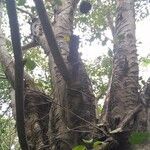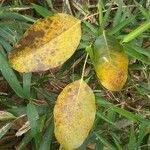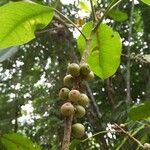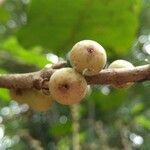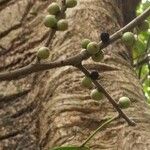Trees, to 25 m tall, trunk straight, d.b.h. 40-50 cm. Bark dark gray, longitudinally fissured. Branchlets reddish green when young, strong, ca. 1 cm in diam., smooth. Stipules caducous, dark red, lanceolate, 10-13 cm, membranous. Petiole terete, robust, 3-5 cm; leaf blade narrowly elliptic to broadly ovate-elliptic, 10-30(or longer) × 8-12 cm, ± leathery, abaxially greenish white, adaxially dark green, base broadly cuneate to rounded, margin entire, apex obtuse or mucronate; basal lateral veins 2, secondary veins 6-9 on each side of midvein, reticulate near margin, and conspicuous on both surfaces when dry. Figs axillary on leafy branchlets, paired, obovoid-ellipsoid to cylindric, 2-2.7 × 1-1.5 cm, apical pore convex, sessile; involucral bracts connate into a cup. Male, gall, and female flowers within same fig. Male flowers: scattered among other flowers; calyx lobes 4, lanceolate; stamen 1; anther ellipsoid, as long as filament. Gall flowers: similar to female flowers but style shorter and thicker. Female flowers: calyx lobes 4 or 5; style lateral; stigma 1, ventricose. Fl. Apr-Oct.
More
A fig. It is a tree. It grows 25 m tall. The trunk is 40-50 cm across. The bark is dark grey with cracks along it. The leaf blade is 10-30 cm long or longer and 8-12 cm across. They are leathery. They are a whitish green underneath and dark green on top. The figs are in the axils of leaves. They occur in pairs and are oval and 2-3 cm across by 1.5 cm wide.
